Book Title: Gambhirpur Rock Paintings Author(s): Ravi G Hajarnis Publisher: Z_Aspect_of_Jainology_Part_2_Pundit_Bechardas_Doshi_012016.pdf View full book textPage 1
________________ GAMBHIRPUR ROCK PAINTINGS Ravi G. Hajarnis The village Gambhirpur (latitude N.P. 23°5% east longitude 7303') is about three kms. to the north of Idar in the Gujarat State. The erstwhile idar State, now merged in the Sābarkāņthā District, is rich in antiquities. The territory of the former Idar State lay mostly to the east of River Sābarmati and north of the River Mahi, between 23°6' and 24°30' north latitude and 72°49' and 73°43' longitude. The State had an area of 1,669 square miles. The Arvalli hills lay on the southern borders of the State. These granite hills almost surround Idar, and some isolated hills occur as far as Himatnagar. The main river system in this territory is formed by the Sābarmati and its tributariesthe sāi, Harņāv, Hathimati, Meśvo, Vātrak and Mājum which flow through the plains of the western and southern parts of the former State. History U. P. Shah traces some connection of Pratihāra King Veņivatsarāja (c. A. D. 783-808) with Idar hills on the basis of folk-lore. According to a legend, the king's mother, consort of the king of Srinagara (i.e. Teheri Ghadhval District of the Himalayan region), was brought to the Idar hills by a monster-bird during her pregnancy. The Chinese pilgrim Hüen T'sang (c. A. D. 640) mentions a place which he calls “O-cha-li”, or Vaļāri. Cunningham identifies this place with idar (also Rāsmālā, 235).3 The Bombay Gazatteer Vol. V, however, identifies Vaļāri with Vadāli (23°56' N. 73°3' E) to the north of Idar.4 According to Shah, Vadāli, which is referred to in Hüen T'sang's accounts, was under the Maitraka rule, with Ānandapura to its west, Mālva or Mālavaka to the east, and Khetaka to its south. He further guesses his route of travel to be from Daśapura (Mandasor), or Ujjain area, to Bfgukaccha via Dungarpur through Bhilodā, Śāmalāji, Harsapura (Harsol) to Kārpațavāņijya (Kapaļvanj), Kathlāl, and Nadiād in Khețakamandala. Devnimori, about 45 kms. to the south of Idar was one of the great Buddhist settlement during the late Kşatrapa period. The cultural and artistic activities of this region, however, go back to a period anterior to Kșatrapa times. The present author, during the course of his explorations discovered rock paintings from Sapāvāda, Lālodā and Idar which has cast fresh light on the art history of this region from stone age to historical periods.? Jain Education International For Private & Personal Use Only www.jainelibrary.orgPage Navigation
1 2 3 4 5
